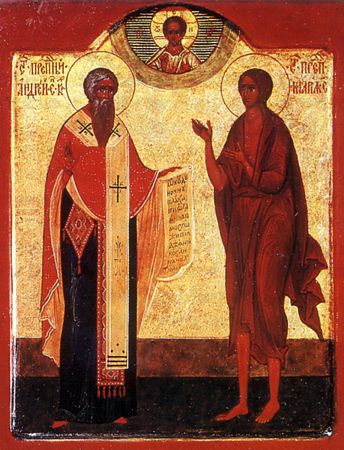- Andrew of Crete
"For the martyr of 766 of the same name, see
Andrew of Crete (martyr) ."Infobox Saint
name=Saint Andrew, Archbishop of Crete
birth_date=c. 650
death_date=July 4 , 8th century
feast_day=July 4
venerated_in=Eastern Orthodox Church 
imagesize=200px
caption=RussianIcon depicting St. Andrew of Crete (left)
andSt. Mary of Egypt
birth_place=Damascus
death_place=Mytilene
titles=Venerable Father
beatified_date=
beatified_place=
beatified_by=
canonized_date=
canonized_place=
canonized_by=
attributes=Vested as abishop , holding aGospel Book orscroll , with his right hand raised in blessing. Iconographically, St. Andrew is depicted with a full head of grey hair and a long, tapering grey beard.
patronage=
major_shrine=
suppressed_date=
issues=
prayer=
prayer_attrib=Saint Andrew (Andreas) of Crete (also known as Andrew of Jerusalem) (c. 650 –
July 4 ,712 , 726 or 740) was an 8th centurybishop ,theologian ,homilist , [A list of forty of his discourses, together with twenty-one edited sermons, is given in "Patrologia Graecae ", XCVII, 801-1304.] andhymnographer .Born in
Damascus of Christian parents, Andrew was a mute from birth until the age of seven, when, according to his hagiographers, he was miraculously cured after receivingHoly Communion . He began hisecclesiastical career at fourteen in theLavra of St.Sabbas the Sanctified , nearJerusalem , where he quickly gained the notice of his superiors. Theodore, thelocum tenens of the Patriarchate of Jerusalem (745 - 770) made him hisArchdeacon , and sent him to the imperial capital ofConstantinople as his official representative at theSixth Ecumenical Council (680 - 681), which had been called by the EmperorConstantine Pogonatus , to counter the heresy ofMonothelitism .Shortly after the Council he was summoned back to Constantinople from Jerusalem and was appointed Archdeacon at the "Great Church" of
Hagia Sophia . Eventually, Andrew was appointed to the metropolitan see ofGortyna , inCrete . Although he had been an opponent of the Monothelite heresy, he nevertheless attended the conciliabulum of 712, in which the decrees of theEcumenical Council were abolished. But in the following year he repented and returned toorthodoxy . Thereafter, he occupied himself with preaching, composing hymns, etc. As a preacher, his discourses are known for their dignified and harmonious phraseology, for which he is considered to be one of the foremost ecclesiastical orators of the Byzantine epoch.Church historians are not of the same opinion as to the date of his death. What is known is that he died on the island of
Mytilene , while returning to Crete from Constantinople, where he had been on church business. Hisrelics were later transferred to Constantinople. In the year 1350 the pious Russian pilgrim Stefan ofNovgorod saw his relics at the Monastery of Saint Andrew of Crete in Constantinople.The
feast day of St. Andrew of Crete is July 4 on theEastern Orthodox liturgical calendar (for those churches which follow theJulian Calendar , July 4 falls onJuly 17 of the modernGregorian Calendar ).Hymnography
Today, St. Andrew is primarily known as a hymnographer. He is credited with the invention (or at least the introduction into Orthodox liturgical services) of the canon, a new form of
hymnody . Previously, the portion of theMatins service which is now the canon was composed of chanting the nine biblical canticles, with short refrains inserted between the scripture verses. St. Andrew expanded these refrains into fully developed poeticOde s, each of which begins with the theme (Irmos ) of the scriptural canticle, but then goes on to expound the theme of the feast being celebrated that day (whether the Lord, theTheotokos asaint , the departed, etc.).His masterpiece, the "Great Canon", is the longest canon ever composed (250
strophes ). It is written primarily in the first person, and goes chronologically through the entire Old andNew Testament s drawing examples (both negative and positive) which it correlates to the need of the sinful soul forrepentance and a humble return to God. It is divided into four parts (called "methymony") which are chanted at Great Compline on the first four nights ofGreat Lent (one part per night); later, it is chanted in its entirety atMatins on Thursday of the fifth week of Great Lent.Twenty-four canons are reputed to have been written by Saint Andrew of Crete. Of these, we can be more or less certain that he wrote fourteen, including: the canons for the Resurrection of Lazarus (chanted at Compline on the Saturday—i.e., Friday night—before
Palm Sunday ); the Conception of St. Anne (9 December ); the Maccabean Martyrs (1 August ); St.Ignatius of Antioch (2 December ), as well as four Triodia, and no fewer than one hundred and eleven irmoi.Notes
External links
* [http://ocafs.oca.org/FeastSaintsViewer.asp?SID=4&ID=1&FSID=101894 St. Andrew Archbishop of Crete]
Icon andSynaxarion of the Saint
* [http://www.westsrbdio.org/prolog/my.html?month=July&day=4&Go.x=12&Go.y=17 St. Andrew, Archbishop of Crete] Prolog from Ochrid (July 4)
* [http://www.newadvent.org/cathen/01473b.htm Andrew of Crete] Article from "The Catholic Encyclopedia "
* [http://orthodoxwiki.org/Great_Canon Great Canon] article from OrthodoxWiki
* [http://www.monachos.net/library/Andrew_of_Crete%2C_Great_Canon_of_Repentance Great Canon of Saint Andrew]
Wikimedia Foundation. 2010.
